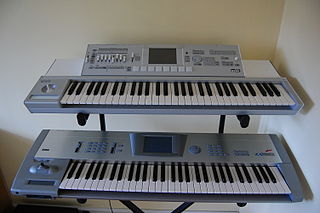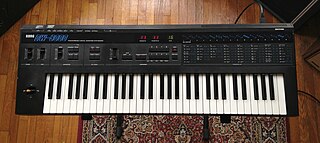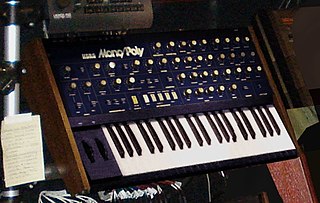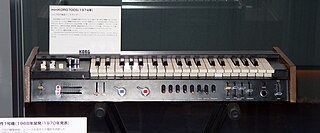
Novation Digital Music Systems Ltd. is a British musical equipment manufacturer, founded in 1992 by Ian Jannaway and Mark Thompson as Novation Electronic Music Systems. Today the company specializes in MIDI controllers with and without keyboards, both analog and virtual analog performance synthesizers, grid-based performance controllers, and audio interfaces. At present, Novation products are primarily manufactured in China.

The Kaoss Pad is a sampler and audio effects processor launched by Korg in 1999. It allows users to record and process audio and apply various effects using an X-Y touchscreen. It has been used by artists including Radiohead, Muse and Brian Eno.

The Korg Triton is a music workstation synthesizer, featuring digital sampling and sequencing, released in 1999. It uses Korg's "HI Synthesis" system and was eventually available in several model variants with numerous upgrade options. The Triton became renowned as a benchmark of keyboard technology, and has been widely featured in music videos and live concerts. At the NAMM Show in 2007, Korg announced the Korg M3 as its successor.

The Korg OASYS is a workstation synthesizer released in early 2005, 1 year after the successful Korg Triton Extreme. Unlike the Triton series, the OASYS uses a custom Linux operating system that was designed to be arbitrarily expandable via software updates, with its functionality limited only by the PC-like hardware.
Electribe is a group of electronic musical instruments by Korg. From its beginnings with the Electribe R to the ESX-1, this series includes both analogue modeling synthesizers and sampling drum machines that can be programmed the same as a drum machine. The analogue modeling synth and sampling drum machine both share a drum-pattern section and a synth-pattern section, whereby the user can not only program drum patterns, but also synth and basslines. These hybrid machines could be considered 'grooveboxes'.

The microKORG is a MIDI-capable digital synthesizer/vocoder from Korg featuring DSP-based analog modelling. The synthesizer is built in such a way that it is essentially a Korg MS-2000 with a programmable step arpeggiator, a less advanced vocoder, lack of motion sequencing, lack of an XLR microphone input, and in a smaller case with fewer real-time control knobs.

The Korg MS-20 is a patchable semi-modular monophonic analog synthesizer which Korg released in 1978 and which was in production until 1983. It was part of Korg's MS series of instruments, which also included the single oscillator MS-10, the keyboardless MS-50 module, the SQ-10 sequencer, and the VC-10 Vocoder. Additional devices included the MS-01 Foot Controller, MS-02 Interface, MS-03 Signal Processor, and MS-04 Modulation Pedal.

The Korg DW-8000 is a polyphonic hybrid digital-analog synthesizer released in 1985. It blends digital waveforms with an analog filter and amplifier, followed by a digital delay for adding echo effects. It boasts eight-note polyphony and its keyboard is equipped with velocity sensitivity and aftertouch.
Arturia is a French electronics company founded in 1999 and based in Grenoble, France. The company designs and manufactures audio interfaces and electronic musical instruments, including software synthesizers, drum machines, analog synthesizers, digital synthesizers, MIDI controllers, sequencers, and mobile apps.

The Korg Prophecy is a monophonic synthesizer released by Korg in 1995. one of the earliest commercial DSP physical/acoustic and analog "virtual" modeling sound synthesizers and Korg's first monophonic synthesizer since the Mono/Poly. The Prophecy employs Korg's Multi Oscillator Synthesis System (MOSS), which features digital oscillators capable of emulating synthesis techniques such as analog synthesis, FM and physical modelling. Emphasized for its portability, expressiveness, and engaging playability, a distinctive feature of the Prophecy is its multifunctional Wheel 3, nicknamed the 'log'.
The Korg Polysix(PS-6) is a six-voice polyphonic analog synthesizer released by Korg in 1981. It was one of the first affordable polyphonic synthesizers on the market, and was released as a cheaper alternative to the Sequential Prophet-5 and Oberheim OB-X, priced at approximately a third of the cost of its contemporaries in the polysynth market. It includes one VCO per voice, enhanced by a chorus/ensemble effect for added richness. It also comes equipped with 32 program memories and an integrated arpeggiator.

The Korg Mono/Poly (MP-4) is a paraphonic analog synthesizer released by Korg in 1981, bridging the gap between monophonic and polyphonic synthesis. Released in the same year as the Korg Polysix, as a complementary synth, The Mono/Poly is equipped with four VCOs and can operate as a four-voice paraphonic synth with limited capabilities, or as a monophonic synth using all four oscillators. Upon its release, it was the only monophonic synthesizer with an integrated quad-VCO design available on the market.

KORG DS-10 is a music creation program for the Nintendo DS that emulates the Korg MS range of synthesizers. Frequently people refer to the Korg MS-10, however the MS-10 is a single oscillator monosynth. The DS-10 adds sync which the Korg MS-20 is lacking. It was released on July 24, 2008, in Japan, October 10, 2008, in Europe, and November 4, 2008, in the United States.

The Kronos is a music workstation manufactured by Korg that combines nine different synthesizer sound engines with a sequencer, digital recorder, effects, a color touchscreen display and a keyboard. Korg's latest flagship synthesizer series at the time of its announcement, the Kronos series was announced at the winter NAMM Show in Anaheim, California in January 2011.

The Korg Z1 is a digital synthesizer released by Korg in 1997. The Z1 built upon the foundation set by the monophonic Prophecy released two years prior by offering 12-note polyphony and featuring expanded oscillator options, a polyphonic arpeggiator and an XY touchpad for enhanced performance interaction. It was the world's first multitimbral physical modelling synthesizer.

The Arturia MiniBrute is a synthesizer manufactured by Arturia. Although the MiniBrute was the first piece of analog hardware created by Arturia—which had previously exclusively marketed software synthesizers—it generated strong sales.

The Korg Minilogue is a polyphonic analog synthesizer released in 2016 by Korg. It offers users four-voice polyphony with two analog VCOs per-voice and was designed to be affordable. It was designed by Korg engineer and synthesizer designer Tatsuya Takahashi, who said "the concept of the Minilogue was to build an analog synthesizer that doesn't rely on the fame and success of an old synth".
The Korg Collection is a suite of virtual instruments and effects that emulate Korg's various hardware synthesizers. The original release included virtual versions of the MS-20, Polysix and Wavestation. Subsequent additions have expanded the collection to feature emulations of the Mono/Poly, M1, ARP Odyssey, Triton, miniKORG 700S, Prophecy and microKORG. These plugins utilize Korg's Component Modeling Technology (CMT) to simulate the analog characteristics of the original instruments. The collection is compatible with VST, AU, and AAX plugin formats and includes standalone versions for use outside a digital audio workstation (DAW).

The miniKORG 700 is a monophonic analog synthesizer released by Korg in 1973, marking their entry into mass-produced synthesizers and their first monophonic synthesizer. It was initially designed to be placed on top of an organ, so its controls are located below the keyboard facing towards the performer. An updated model, the miniKORG 700S, was launched in 1974, introducing a second oscillator that could be detuned, along with additional sustain and vibrato controls.
















